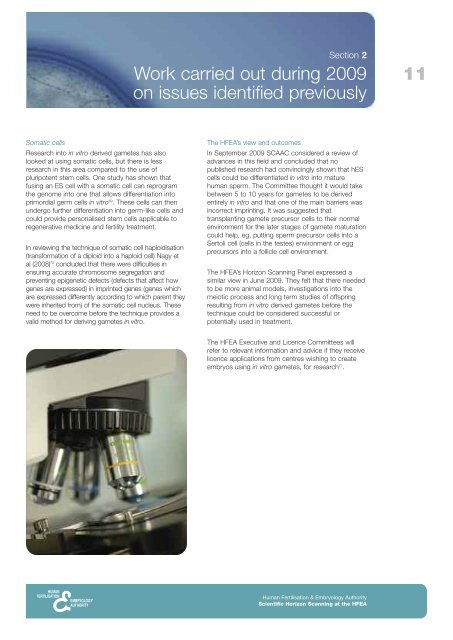Annual report 2009/10 - Human Fertilisation and Embryology Authority
Annual report 2009/10 - Human Fertilisation and Embryology Authority
Annual report 2009/10 - Human Fertilisation and Embryology Authority
Create successful ePaper yourself
Turn your PDF publications into a flip-book with our unique Google optimized e-Paper software.
Section 2<br />
Work carried out during <strong>2009</strong><br />
on issues identified previously<br />
11<br />
Somatic cells<br />
Research into in vitro derived gametes has also<br />
looked at using somatic cells, but there is less<br />
research in this area compared to the use of<br />
pluripotent stem cells. One study has shown that<br />
fusing an ES cell with a somatic cell can reprogram<br />
the genome into one that allows differentiation into<br />
primordial germ cells in vitro 69 . These cells can then<br />
undergo further differentiation into germ-like cells <strong>and</strong><br />
could provide personalised stem cells applicable to<br />
regenerative medicine <strong>and</strong> fertility treatment.<br />
In reviewing the technique of somatic cell haploidisation<br />
(transformation of a diploid into a haploid cell) Nagy et<br />
al (2008) 70 concluded that there were difficulties in<br />
ensuring accurate chromosome segregation <strong>and</strong><br />
preventing epigenetic defects (defects that affect how<br />
genes are expressed) in imprinted genes (genes which<br />
are expressed differently according to which parent they<br />
were inherited from) of the somatic cell nucleus. These<br />
need to be overcome before the technique provides a<br />
valid method for deriving gametes in vitro.<br />
The HFEA’s view <strong>and</strong> outcomes<br />
In September <strong>2009</strong> SCAAC considered a review of<br />
advances in this field <strong>and</strong> concluded that no<br />
published research had convincingly shown that hES<br />
cells could be differentiated in vitro into mature<br />
human sperm. The Committee thought it would take<br />
between 5 to <strong>10</strong> years for gametes to be derived<br />
entirely in vitro <strong>and</strong> that one of the main barriers was<br />
incorrect imprinting. It was suggested that<br />
transplanting gamete precursor cells to their normal<br />
environment for the later stages of gamete maturation<br />
could help, eg, putting sperm precursor cells into a<br />
Sertoli cell (cells in the testes) environment or egg<br />
precursors into a follicle cell environment.<br />
The HFEA’s Horizon Scanning Panel expressed a<br />
similar view in June <strong>2009</strong>. They felt that there needed<br />
to be more animal models, investigations into the<br />
meiotic process <strong>and</strong> long term studies of offspring<br />
resulting from in vitro derived gametes before the<br />
technique could be considered successful or<br />
potentially used in treatment.<br />
The HFEA Executive <strong>and</strong> Licence Committees will<br />
refer to relevant information <strong>and</strong> advice if they receive<br />
licence applications from centres wishing to create<br />
embryos using in vitro gametes, for research 71 .<br />
<strong>Human</strong> <strong>Fertilisation</strong> & <strong>Embryology</strong> <strong>Authority</strong><br />
Scientific Horizon Scanning at the HFEA

















